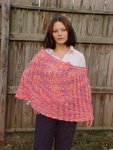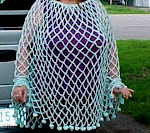In the spirit of earth day I thought I'd use my posting today to explore some of the ways in which crochet either has already been or has become an earth friendly craft.
There are several options in organic materials such as soy, bamboo, linen, hemp, cotton, silk and animal fibers. These can be made even more earth friendly by using organic farming methods in the growing raising stages.
Looking around on the web I came up with several places that cater to organic fibers. I will focus today on those organic fibers that are grown rather than raised. Please keep in mind that I in no way endorse any of the companies or sites that I've posted. I simply thought my readership would like to have some links with which to check out the various options.
First stop is a place that sells organic Tussah yarns. Tussah are silk worms that live in the wild. Their silk is gathered after the worms have emerged as moths. This method is kinder and friendlier than traditional silkworm production which incorporates the destruction of the silkworm that chews on the mulberry leaves in quite a nasty manner. Traditional silkworm cultivation calls for the destruction of the silkworm before it emerges from the cocoon by boiling or baking. So you can see that Tussah cultivation is truly earth friendly, no killing, no boiling, and no chemicals. The yarns come naturally colored with earth tones that, depending upon what the worm has been eating, range in color from beige to brown.
http://www.aurorasilk.com/shop/tussah.shtml
Another option in yarn is bamboo. You can find them here:
http://tinyurl.com/mc7nu
http://tinyurl.com/yqo7yh
http://tinyurl.com/22bn42
Bamboo yarn is made by processing the bamboo grass stalk and combing the fiber strands from the plant. In addition bamboo yarn is naturally anti-bacterial, breathable and cool, and acts as a natural UV blocker.
Hemp yarn is another alternative that is natural. You can find this product in many places today, including:
http://www.aurorasilk.com/shop/hemp_yarn.shtml
http://www.lanaknits.com/usayarn.html
http://www.handknitting.com/s.nl?alias=&whence=
http://www.yarnmarket.com/knitting/Hemp_for_Knitting-635.html
Linen is another natural fiber that is used to make yarns. Linen yarn is made from flax fibers and may be the oldest textile material in the world. Linen has a high natural luster and natural color ranges between shades of ivory, tan, or grey and when prepared properly, has the ability to absorb and lose water rapidly. Sources for linen yarns include:
http://tinyurl.com/yqmo4v
http://tinyurl.com/236d3h
http://tinyurl.com/sk6om
http://tinyurl.com/2z3pn5
Soy yarn is an environmentally friendly fiber made from tofu manufacturing waste. Soy protein is liquefied and then extruded into long, continuous fibers that are then cut and processed like any other spinning fiber. You can find it here:
http://tinyurl.com/3apsax
http://tinyurl.com/34caey
http://tinyurl.com/33lk2r
Cotton yarn is a more familiar and accessible fiber for crochet. The trick is to find cottons that are environmentally friendly, that have been grown and dyed organically. Some sources:
http://tinyurl.com/2ehnyj
http://tinyurl.com/3blj4z
http://tinyurl.com/2jbbna
http://tinyurl.com/2kkotd
http://tinyurl.com/3bgzl7
There now is a brief overview of various organically grown fibers/yarns. I'm sure there are many more sources out there, I just happened to come upon these and chose to use them. I'm sure if I were to try and incorporate more of them I could be at this all day. I hope you all will consider trying some of these at some point. I have yet to do so myself, but have plans on trying a few, especially the soy and bamboo yarns. They sound so yummy!
Sunday, April 22
Subscribe to:
Post Comments (Atom)













No comments:
Post a Comment